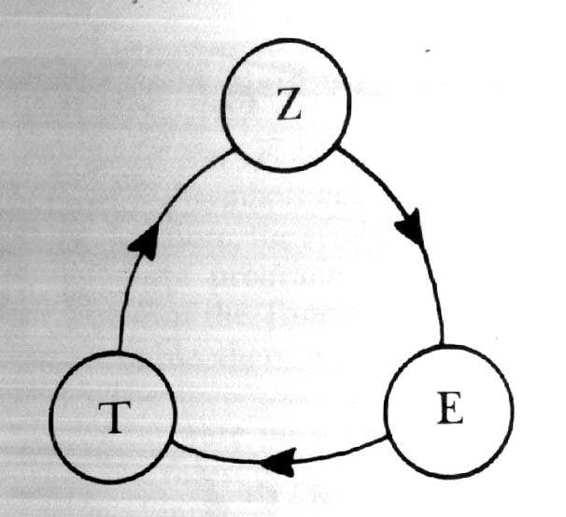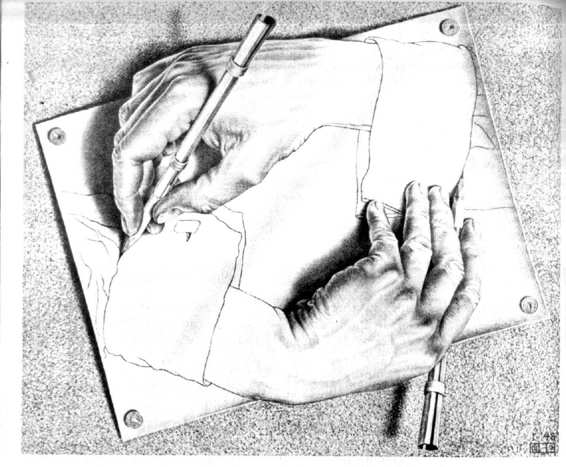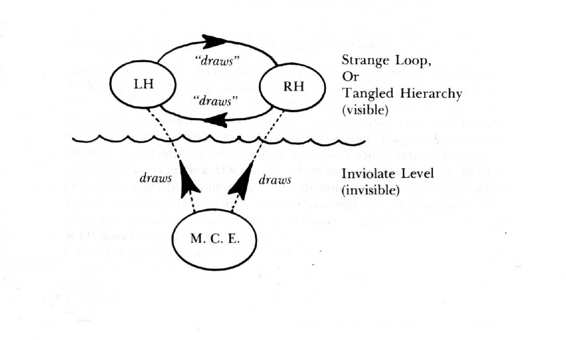Gödel, Escher, Bach: An Eternal Golden Braid (126 page)
Read Gödel, Escher, Bach: An Eternal Golden Braid Online
Authors: Douglas R. Hofstadter
Tags: #Computers, #Art, #Classical, #Symmetry, #Bach; Johann Sebastian, #Individual Artists, #Science, #Science & Technology, #Philosophy, #General, #Metamathematics, #Intelligence (AI) & Semantics, #G'odel; Kurt, #Music, #Logic, #Biography & Autobiography, #Mathematics, #Genres & Styles, #Artificial Intelligence, #Escher; M. C

But I am not interested in pursuing the strange topic of the ever more abstruse tanglings which can arise in self-modifying chess. The point of this has been to show, in a somewhat graphic way, how in any system there is always some "protected" level which is unassailable by the rules on other levels, no matter how tangled their interaction may be among themselves. An amusing riddle from Chapter IV illustrates this same idea in a slightly different context. Perhaps it will catch you off guard:

FIGURE 134.
An “authorship triangle
”
There are three authors-Z, T, and E. Now it happens that Z exists only in a novel by T. Likewise, T exists only in a novel by E. And strangely, E, too, exists only in a novel-by Z, of course. Now, is such an "authorship triangle"
really
possible? (See Fig. 134.)
Of course it's possible. But there's a trick ... All three authors Z, T, E, are themselves characters in another novel-by H! You can think of the Z-T-E triangle as a Strange Loop, Or Tangled Hierarchy; but author H is outside of the space in which that tangle takes place-author H is in an inviolate space. Although Z, T, and E all have access-direct or indirect-to each other, and can do dastardly things to each other in their various novels, none of them can touch H's life! They can't even imagine him-no more than you can imagine the author of the book
you're
a character in. If I were to draw author H, I would represent him somewhere off the page. Of course that would present a problem, since drawing a thing necessarily puts it
onto
the page ... Anyway, H is really outside of the world of Z, T, and E, and should be represented as being so.
Escher's
Drawing Hands
Another classic variation on our theme is the Escher picture of
Drawing Hands
(Fig.
135). Here, a left hand (LH) draws a right hand (RH), while at the same time, RH draws LH. Once again, levels which ordinarily are seen as hierarchical-that which draws, and that which is drawn-turn back on each other, creating a Tangled Hierarchy. But the theme of the Chapter is borne out, of course, since behind it all lurks the undrawn but drawing hand of M. C. Escher, creator of both LH and RH. Escher is outside of the two-hand space, and in my schematic version of his picture (Fig. 136), you can see that explicitly.
In this schematized representation of the Escher picture, you see the Strange Loop, Or Tangled Hierarchy at the top; also, you see the Inviolate Level below it, enabling it to come into being. One could further Escherize the Escher picture, by taking a photograph of a hand drawing it. And so on.


FIGURE 135.
Drawing Hands, by M. C. Escher (lithograph, 1948
).
FIGURE 136.
Abstract diagram of M. C. Escher's Drawing Hands. On top, a seeming
paradox. Below, its resolution
.
Brain and Mind:
A Neural Tangle Supporting a Symbol Tangle
Now we can relate this to the brain, as well as to Al programs. In our thoughts, symbols activate other symbols, and all interact heterarchically. Furthermore, the symbols may cause each other to change internally, in the fashion of programs acting on other programs. The illusion is created, because of the Tangled Hierarchy of symbols, that there is no inviolate level. one thinks there is no such level because that level is shielded from our view.
If it were possible to schematize this whole image, there would be a gigantic forest of symbols linked to each other by tangly lines like vines in a tropical jungle-this would be the top level, the Tangled Hierarchy where thoughts really flow back and forth.
This is the elusive level of mind: the analogue to LH and RH. Far below in the schematic picture, analogous to the invisible "prime mover" Escher, there would be a representation of the myriad neurons-the "inviolate substrate" which lets the tangle above it come into being. Interestingly, this other level is itself a tangle in a literal sense-billions of cells and hundreds of billions of axons, joining them all together.
This is an interesting case where a software tangle, that of the symbols, is supported by a hardware tangle, that of the neurons. But only the symbol tangle is a Tangled Hierarchy. The neural tangle is* ust a "simple" tangle. This distinction is pretty much the same as that between Strange Loops and feedback, which I mentioned in Chapter XVI. A Tangled Hierarchy occurs when what you presume are clean hierarchical levels take you by surprise and fold back in a hierarchy-violating way. The surprise element is important; it is the reason I call Strange Loops "strange". A simple tangle, like feedback, doesn't involve violations of presumed level distinctions. An example is when you're in the shower and you wash your left arm with your right, and then vice versa.
There is no strangeness to the image. Escher didn't choose to draw hands drawing hands for nothing!
Events such as two arms washing each other happen all the time in the world, and we don't notice them particularly. I say something to you, then you say something back to me. Paradox % No; our perceptions of each other didn't involve a hierarchy to begin with, so there is no sense of strangeness.
On the other hand, where language does create strange loops is when it talks about itself, whether directly or indirectly. Here, something in the system jumps out and acts on the system, as if it were outside the system. What bothers us is perhaps an ill-defined sense of topological wrongness: the inside-outside distinction is being blurred, as in the famous shape called a "Klein bottle". Even though the system is an abstraction, our minds use spatial imagery with a sort of mental topology.
Getting back to the symbol tangle, if we look only at it, and forget the neural tangle, then we seem to see a self-programmed object-in just the same way as we seem to see a self-drawn picture if we look at
Drawing Hands
and somehow fall for the illusion, by forgetting the existence of Escher. For
the picture, this is unlikely-but for humans and the way they look at their minds, this is usually what happens. We
feel
self-programmed. Indeed, we couldn't feel any other way, for we are shielded from the lower levels, the neural tangle. Our thoughts seem to run about in their own space, creating new thoughts and modifying old ones, and we never notice any neurons helping us out! But that is to be expected. We can't.
An analogous double-entendre can happen with
LISP
programs that are designed to reach in and change their own structure. If you look at them on the
LISP
level, you will say that they change themselves; but if you shift levels, and think of
LISP
programs as data to the
LISP
interpreter (see Chapter X), then in fact the sole program that is running is the interpreter, and the changes being made are merely changes in pieces of data. The
LISP
interpreter itself is shielded from changes.
How you describe a tangled situation of this sort depends how far back you step before describing. If you step far enough back, you can often see the clue that allows you to untangle things.
Strange Loops in Government
A fascinating area where hierarchies tangle is government-particularly in the courts.
Ordinarily, you think of two disputants arguing their cases in court, and the court adjudicating the matter. The court is on a different level from the disputants. But strange things can start to happen when the courts themselves get entangled in legal cases.
Usually there is a higher court which is outside the dispute. Even if two lower courts get involved in some sort of strange fight, with each one claiming jurisdiction over the other, some higher court is outside, and in some sense it is analogous to the inviolate interpretation conventions which we discussed in the warped version of chess.
But what happens when there is no higher court, and the Supreme Court itself gets all tangled up in legal troubles? This sort of snarl nearly happened in the Watergate era.
The President threatened to obey only a "definitive ruling" of the Supreme Court-then claimed he had the right to decide what is "definitive". Now that threat never was made good; but if it had been, it would have touched off a monumental confrontation between two levels of government, each of which, in some ways, can validly claim to be "above"
the other-and to whom is there recourse to decide which one is right? To say "Congress"
is not to settle the matter, for Congress might command the President to obey the Supreme Court, yet the President might still refuse, claiming that he has the legal right to disobey the Supreme Court (and Congress!) under certain circumstances. This would create a new court case, and would throw the whole system into disarray, because it would be so unexpected, so Tangled-so Strange!
The irony is that once you hit your head against the ceiling like this, where you are prevented from jumping out of the system to a yet higher authority, the only recourse is to forces which seem less well defined by
rules, but which are the only source of higher-level rules anyway: the lower-level rules, which in this case means the general reaction of society. It is well to remember that in a society like ours, the legal system is, in a sense, a polite gesture granted collectively by millions of people-and it can be overridden just as easily as a river can overflow its banks. Then a seeming anarchy takes over; but anarchy has its own kinds of rules, no less than does civilized society: it is just that they operate from the bottom up, not from the top down. A student of anarchy could try to discover rules according to which anarchic situations develop in time, and very likely there are some such rules.
An analogy from physics is useful here. As was mentioned earlier in the book, gases in equilibrium obey simple laws connecting their temperature, pressure, and volume. However, a gas can violate those laws (as a President can violate laws)-provided it is not in a state of equilibrium. In nonequilibrium situations, to describe what happens, a physicist has recourse only to statistical mechanics-that is, to a level of description which is not macroscopic, for the ultimate explanation of a gas's behavior always lies on the molecular level, just as the ultimate explanation of a society's political behavior always lies at the "grass roots level". The field of nonequilibrium thermodynamics attempts to find macroscopic laws to describe the behavior of gases (and other systems) which are out of equilibrium. It is the analogue to the branch of political science which would search for laws governing anarchical societies.